Picture This
Making a charitable contribution as a part of your exhibit program is great, but many exhibitors miss the opportunity to involve attendees. Online job board CareerBuilder LLC let booth visitors get in on the altruistic action at the Society of Human Resource Management Annual Conference and Exposition.
In the weeks leading up to the show, CareerBuilder sent select attendees a mailer informing them of two ways they could contribute to the company's donation to I.c.stars, a charity that provides computer-skills training for low-income adults in Chicago. The first option invited attendees to bring a ticket included in the mailer to the exhibit. For each recipient that did so, the company pledged to donate $10. The second opportunity, which was also advertised via exhibit signage, required attendees to snap pics at the show and post them on Instagram or Twitter using the hashtags #SHRM13. and #EmpoweringEmployment. CareerBuilder donated $5 for each photo posted according to its criteria, and used the photos in digital collages of popular Chicago landmarks, which were then displayed on screens throughout the booth.
By the end of the show, CareerBuilder had pledged more than $3,100 from attendees returning their tickets, and roughly $6,900 via the photo challenge, meeting its goal of a $10,000 donation to I.c.stars. Not only did the two-part promo result in a check for the charity, but also it helped the company generate impressive results. CareerBuilder left SHRM with more than 1,000 leads, and recorded a 50-percent increase in booth traffic over the previous year's show, leaving attendees – and management – with warm and fuzzy feelings about the promotion.
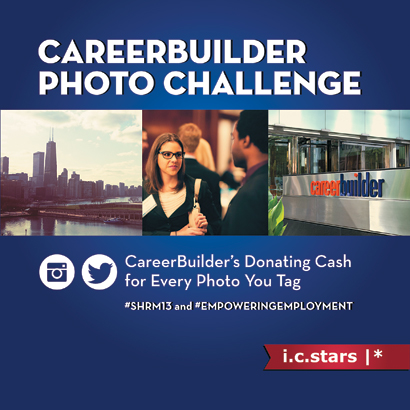
Signage in CareerBuilder LLC's exhibit at the Society of Human Resource Management Annual Conference and Exposition informed attendees that every picture shared
on social media was worth a $5 donation to I.c.stars.
A Hog and a Hero
Once in a while, exhibitors manage to create cause-marketing campaigns that tug so forcefully at attendees' heartstrings that they forge a nearly impenetrable bond between their respective brands and the subsequent goodwill. Jet Aviation, a subsidiary of General Dynamics Corp., successfully executed just such a campaign at the National Business Aviation Association show in Las Vegas. To promote its workers' design and manufacturing skills, Jet Aviation asked its employees to donate their time to customize a Harley Davidson motorcycle. The end product would be given to a wounded service member through a joint partnership with the Wounded Warrior Project and Operation Homefront.
As part of a promotion dubbed Operation Hog, the Harley, which was presented to former Army Specialist Chad Hembree in a ceremony inside Jet Aviation's exhibit, was transformed into a rolling account of the soldier's heroic service in Afghanistan. Of course, the in-booth ceremony generated a fair amount of exhibit traffic and media attention, but sometimes even the most impressive metrics pale in comparison to the intangible benefits of giving back.
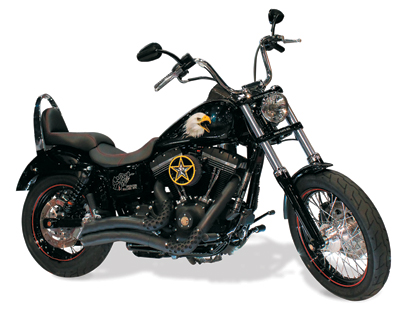
Jet Aviation employees customized a Harley Davidson motorcycle, which was given to an army veteran.
Service Learning
Getting attendees to join with you in donating dollars to a good cause is great for building brand equity, but if an exhibitor can get them to donate their professional skills to actually build something, that's even better. CMD Group LLC (formerly known as Reed Construction Data) did just that at the 2014 American Institute of Architects Convention in Chicago. The company teamed up with AEC Cares, an organization that works with the American Institute of Architects and Hanley Wood to match visiting architects' skills to a worthy project in the show city.
To execute the plan, CMD Group orchestrated the rehab of an early childhood learning facility akin to what viewers see on "Extreme Makeover: Home Edition." The day before the show opened, roughly 180 volunteers descended on the Metropolitan Family Services' Learning and Wellness Center in Chicago's South Side neighborhood for a blitz build. Using more than $100,000 in materials donated by CMD Group, architects transformed the utilitarian annex of Arthur A. Libby Elementary School into a colorful, welcoming space for low-income children ranging in age from newborn to 5 years old. But CMD Group's charity-centric strategy for AIA 2014 didn't stop there.

Attendees added "Fingersmears" to a mural in CMD Group LLC's exhibit at the American Institute of Architects Convention. The finished product was donated to the Metropolitan Family Services' Learning and Wellness Center.
The contracting-industry services provider gave attendees who couldn't make it to the work site a chance to contribute to the project. The company hung a 5-by-7-foot canvas on the back wall of its exhibit, and enlisted Kelly Sullivan of Sullivan Fine Arts to facilitate a "Fingersmears" finger-painting activity. Sullivan invited attendees to dab their fingers in globs of paint on her palette, make streaks across the canvas, and wipe the residual paint onto her white smock. Then a CMD Group staffer handed them a Sharpie to sign their names on the canvas and scanned their badge. The completed artwork depicted several Chicago landmarks, including Wrigley Field, the Magnificent Mile, and Willis Tower, and was hung in the lobby of the Learning and Wellness Center after the close of the trade show.
To put the finishing touches on the campaign, CMD Group sent a postcard to each of the more than 400 attendees who signed the painting. The 6-by-8-inch mailer had an image of the completed artwork on its front, and a brief note from the company thanking the recipient for his or her contribution to the project on the back. Talk about painting a positive brand image for attendees.
A Sweet Reward
We've all heard that giving is better than receiving. But at the Realtors Conference and Expo in San Francisco, Wells Fargo Home Mortgage, a division of Wells Fargo Bank N.A., proved that it can be sweeter, too. The show, which is hosted by the National Association of Realtors, attracts roughly 17,000 realtors and other members of the housing industry each year. To give back to the industry, generate some goodwill among its target audience, and attract attendees' attention at the show, Wells Fargo opted for a philanthropic promotion that was as sweet as candy.
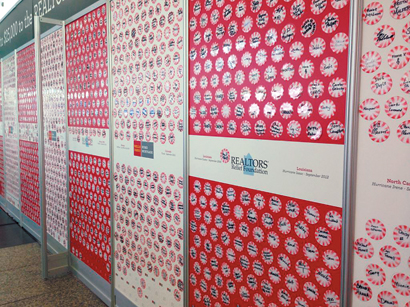
Realtors signed peppermint-candy-shaped stickers affixed to a wall in the Moscone Center lobby. Wells Forgo Home Mortgage then donated $25,000 to the Realtors Relief Foundation.
Staffers invited attendees to step up to Wells Fargo's Realtors Relief Wall in the lobby of the Moscone Center. At the start of the show, the 62-by-9-foot wall featured little more than 5,000 circle-shaped outlines. But throughout the event, people signed their names on peppermint-candy-shaped stickers and affixed them to one of 20 panels comprising the wall. Each signed sticker represented the signee's support for the Realtors Relief Foundation, an offshoot of the National Association of Realtors that assists victims of natural disasters. A placard on each panel listed a recent natural disaster where the Realtors Relief Foundation had contributed to the recovery work, and signage above of the display informed attendees that "Giving just got a whole lot sweeter!"
The simple yet successful promotion created an eye-catching and evolving piece of branded signage at the trade show, reiterated Wells Fargo's "Home Sweet Home" theme for the event, and got attendees involved in supporting a cause that was relevant to the industry. At the show's end, each of the 5,000 slots on the wall was covered with a sticker bearing a visitor's name, inspiring the mortgage lender's $25,000 donation, and leaving attendees with a sugarcoated impression of Wells Fargo.
Signing On
For many people, their signature is more than just a series of scribbles forming their name; it's a tangible part of who they are. So getting attendees to contribute their signature can be an effective way to cement their support for your company's charitable cause. At the American Academy of Dermatology Annual Meeting, Bayer AG gave attendees the opportunity to add their autograph to a signing wall to show their support for Camp Discovery. The summer camp program, sponsored by the American Academy of Dermatology, gives kids with chronic skin conditions an unforgettable experience free of charge.
Staffers invited attendees to step up to the 10-by-6-foot signing wall in the 30-by-50-foot exhibit. The structure, crafted by Visual Communications Inc., featured little more than nine white, 2-foot-square tiles that came together to form a black outline of Bayer's logo. That is, of course, until attendees added their names with a silver marker to the interior portions of the logo.
A short paragraph of text along the bottom of the signing wall explained the promotion: "We know that you show your dedication to your patients every day through the art and science of Dermatology. Help Bayer HealthCare show our dedication to your patients. Every signature will help the children of Camp Discovery. Camp Discovery provides a life-enriching camping experience every summer for children with chronic skin conditions at six camps throughout the country." For each signature on the wall, Bayer pledged a donation to the camp. The signature wall encouraged attendees to engage with Bayer staffers, and it let them leave the booth feeling like they had really made a difference. All in all, Bayer garnered more than 600 signatures from attendees (and an equal number of badge scans from the lead station positioned in the booth), and donated more than $6,000 to Camp Discovery.

Physicians attending the American Academy of Dermatology Annual Meeting signed white tiles to show their support for Camp Discovery. The activity attracted 600 participants resulting in a donation to the camp from Bayer AG.
Water Works
Attendees may rebuff devoting some of their precious time on the show floor to a blatant sales pitch, but most will give a few minutes for a good cause. So at EXHIBITOR2014 (now known as EXHIBITOR
LIVE), an annual conference and trade show for exhibit and event managers, Spoon Exhibit Services Inc. tapped attendees' willingness to give back by partnering with The Water Project, a nonprofit organization that provides communities with access to clean drinking water. And rather than just writing a check and telling people about it, Spoon let attendees take part in the charitable contribution by playing a game.
Staffers invited booth visitors to take a chip and play a round of Plinko – a game made popular by the television game show "The Price is Right." But instead of giving them a prize, Spoon rewarded players by making a donation to The Water Project in their honor. Attendees dropped a CD-sized chip at the top of a roughly 3-foot-tall slotted board. The chip then slid down the board until it landed in one of five slots, representing amounts ranging from $5 to $25.
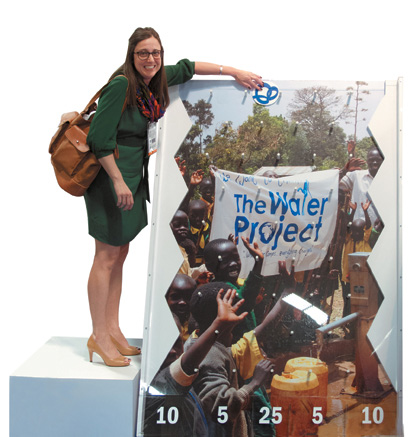
Attendees at EXHIBITOR2014 played a version of Plinko in Spoon Exhibit Services Inc.'s booth. The disk they dropped determined the dollar amount donated to The Water Project.
Select attendees received a branded Plinko chip as part of a pre-show direct mailer, which they could bring to the booth to double the amount of their charitable contribution. After dropping their chips down the Plinko board, booth visitors were guided to one side of the exhibit where they signed a paper cutout in the shape of a water droplet and taped it on the aisle-facing wall, creating a visual representation of the company's philanthropic efforts – and the number of attendees who had taken part. All in all, the smart strategy created precious minutes of staff/attendee engagement and a $2,500 donation to The Water Project.
Survey Says
Incentivizing participation is an easy way to boost the response rate for in-booth surveys. But at health-care shows such as the Radiological Society of North America Annual Meeting, giveaways come with red tape due to government regulations. So Hitachi Medical Systems America Inc., a subsidiary of Hitachi Medical Corp., took a philanthropic route by inviting attendees to make a donation on its dime in exchange for completed surveys.
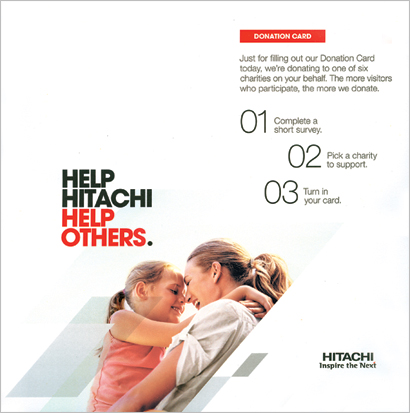
Hitachi Medical Systems America Inc. made a donation to medical-related charities for every attendee survey completed in its booth.
Brand ambassadors stationed near the aisles of its 80-by-160-foot exhibit flagged down passersby and encouraged them to fill out a survey. The 9-by-9-inch card asked for attendees' job titles and preferred social-networking sites, as well as the medical journals they read, the radiology websites they regularly visit, and what they had learned about Hitachi during their booth visit. Finally, the survey requested that attendees select one of six medical-related charities.
In return for their feedback, Hitachi donated $10 per completed survey card to the attendee's charity of choice. The simple, eight-question card didn't just help Hitachi determine where to allocate its advertising dollars; it also spread feel-good vibes around the show floor, while supporting a half-dozen charities in the process.

Do-Gooder Details
Having a great cause-marketing campaign is only half the battle of adding a philanthropic promotion to your next exhibit. Here are some additional steps that will help your altruistic endeavors translate to show-floor success.
 Reputation Research
Reputation Research
When a donation is coming out of your own pocket, you likely exercise a little due diligence in assessing
the financial practices of the intended recipient. But are you as picky when the cash is coming
from corporate coffers? Sites such as the Better Business Bureau (www.bbb.org/us/charity), Charity
Navigator (www.charitynavigator.org), and Give Well (www.givewell.org) all have tools for appraising charities'
reputations to make sure your goodwill is going to an equally good cause.
 Health Concerns
Health Concerns
Charitable contributions seem like a perfect go-around to stringent Sunshine Act regulations (which
strictly regulate gifts to health-care providers), but exhibitors in the health-care industry need to
make sure they read the fine print. Pat Friedlander, owner of Word-Up, a Chicago-based public relations and
marketing consultancy, cautions exhibitors against making donations in health-care providers' names, because
exhibiting companies are required to report such donations to The Center for Medicare & Medicaid Services
(CMS). Exhibitors can avoid the hassle of reporting donations by allocating dollars based on how many attendees
complete a specified action, and then make a donation without naming individual participants.
 Thankful Follow-Up
Thankful Follow-Up
Post-show follow-up is important no matter what type of traffic builder you employ in your exhibit, but it is
critical when you tell attendees about a pending charitable donation. Send participants a note reiterating
the final figure of your company's total donation. Or, better yet, ask the charity to do so on your company's behalf.
You may also want to consider a press release to alert your industry that you made good on your promises.















